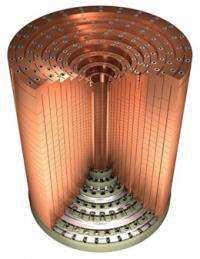Superconductivity: The puzzle is taking shape

By destabilizing superconductivity with a strong magnetic field, the electrons of a "high temperature" superconductor align into linear filaments. This phenomenon has been demonstrated by a team of researchers at the CNRS Laboratoire National des Champs Magnetiques Intenses. Published in Nature on the 8 September 2011, these results add a new piece to the puzzle that condensed-matter physicists have been trying to put together for nearly twenty-five years.
Discovered a century ago, superconductivity is a spectacular phenomenon that is still intriguing researchers. What are known as "high temperature" superconductors are of particular interest to scientists, especially cuprates, i.e. copper oxides whose maximum superconducting temperature is around -140°C. How do electrons manage to organize themselves into a single wave in these cuprates, thereby allowing the material to become a superconductor? This is the question that researchers have been trying to answer for the last twenty-five years.
It is in this context that the team from the Laboratoire National des Champs Magnétiques Intenses, in collaboration with scientists from Vancouver, subjected samples of a cuprate known as “YBaCuO” to particularly strong magnetic fields (thousands of times more powerful than those of the small magnets used on fridge doors). Using the technique of nuclear magnetic resonance, the researchers probed this superconductor at the atomic scale and discovered that electrons, under such intense fields, tend to align into rectilinear filaments or “stripes”.
Such an alignment of charges has only ever been observed previously in non-superconducting or weakly superconducting materials but never in materials with high superconductivity. This discovery makes it possible to understand why this is so: a strong magnetic field must weaken superconductivity for the effect to be observed. The results also suggest that this alignment could be an underlying tendency in all cuprates. However, it is still not clear whether this new piece of the puzzle has any relation with the superconductivity mechanism of these materials.
More information: Magnetic-field-induced charge-stripe order in the high temperature superconductor YBa2Cu3Oy l T. Wu, et al. Nature, 8 September 2011.
Provided by CNRS



















